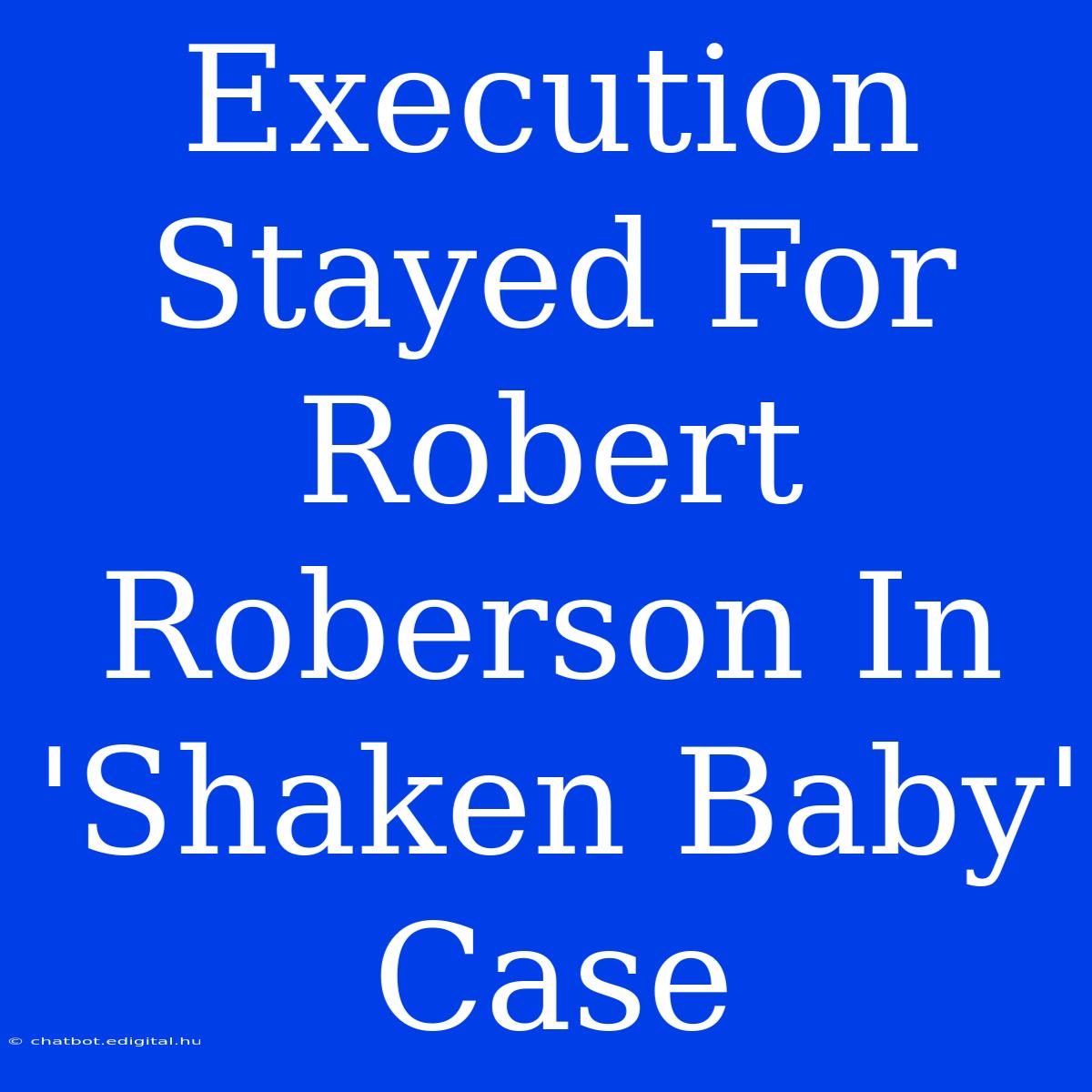Execution Stayed For Robert Roberson In 'Shaken Baby' Case: A Complex Case with Uncertain Outcomes
Is the 'Shaken Baby' syndrome a reliable diagnosis? The case of Robert Roberson, a man convicted of murder in a "shaken baby" case, has been met with controversy and legal challenges. His execution has been stayed, raising crucial questions about the scientific certainty of the 'shaken baby' syndrome diagnosis and the justice system's handling of such cases.
Editor Note: The execution of Robert Roberson has been stayed, highlighting the ongoing debate surrounding the 'shaken baby' syndrome diagnosis and the legal complexities of these cases.
This case is significant because it underscores the challenges inherent in "shaken baby" cases, where medical evidence often relies on complex interpretations. The lack of clarity surrounding the precise nature of the injuries and the possibility of alternative explanations for the baby's condition raise questions about the reliability of the "shaken baby" syndrome diagnosis and the potential for wrongful convictions.
Analysis: We reviewed court documents, medical reports, and expert testimony related to Robert Roberson's case. This analysis seeks to understand the scientific basis of the "shaken baby" syndrome diagnosis and the legal arguments presented in Roberson's case.
Key Takeaways of the Roberson Case:
| Key Takeaway | Explanation |
|---|---|
| Controversial Diagnosis | The "shaken baby" syndrome diagnosis remains controversial, with some experts questioning its reliability and specificity. |
| Legal Challenges | Roberson's case has faced multiple legal challenges, raising questions about the sufficiency of evidence and the prosecution's arguments. |
| Scientific Debate | The scientific community continues to debate the precise mechanisms and potential causes of the injuries associated with "shaken baby" syndrome. |
The "Shaken Baby" Syndrome
The "shaken baby" syndrome, also known as abusive head trauma (AHT), refers to a constellation of injuries often observed in infants, including brain damage, bleeding in the brain (subdural hematoma), and retinal hemorrhages. These injuries are commonly attributed to forceful shaking of the baby.
Medical Evidence and Interpretation
The diagnosis of AHT often relies on medical evidence such as the presence of specific injuries, the absence of other potential causes, and the infant's age and developmental stage. However, the interpretation of this evidence can be complex and subjective.
Controversies and Challenges
- Alternative Causes: Some medical experts argue that the injuries observed in "shaken baby" cases could be caused by other factors, such as pre-existing medical conditions, accidental falls, or even birth injuries.
- Specificity: The "shaken baby" syndrome diagnosis is not always specific, meaning that the injuries could be caused by various mechanisms, not just shaking.
- Lack of Consensus: There is no consensus among medical professionals regarding the precise characteristics of the "shaken baby" syndrome and the diagnostic criteria used to identify it.
Legal Implications
The complexities and uncertainties surrounding the "shaken baby" syndrome have significant legal implications, particularly in criminal cases where the diagnosis is used to support charges of child abuse or murder. The burden of proof in these cases rests with the prosecution, which must demonstrate that the injuries were caused by shaking and not by other factors.
Robert Roberson's Case
In Robert Roberson's case, the prosecution relied heavily on the "shaken baby" syndrome diagnosis to convict him of murder. However, Roberson's defense argued that the baby's injuries could have been caused by other factors, including pre-existing medical conditions or an accidental fall. The case has been subject to numerous appeals, and the execution has been stayed pending further review.
The Ongoing Debate
The Roberson case highlights the need for ongoing research and debate surrounding the "shaken baby" syndrome diagnosis. Medical professionals and legal experts must continue to refine diagnostic criteria, understand the potential for alternative causes, and develop best practices for investigating and prosecuting these complex cases.
FAQ
Q: What are the most common injuries associated with the "shaken baby" syndrome? A: The most common injuries include brain damage, bleeding in the brain (subdural hematoma), retinal hemorrhages, and fractures of the ribs or skull.
Q: What are the challenges in diagnosing the "shaken baby" syndrome? A: The challenges include distinguishing between shaking and other potential causes of the injuries, the subjective interpretation of medical evidence, and the lack of consensus among medical professionals regarding diagnostic criteria.
Q: Why is the Roberson case important? A: The Roberson case highlights the legal and ethical complexities surrounding the "shaken baby" syndrome diagnosis and the need for careful and thorough investigations in these cases.
Tips for Understanding the "Shaken Baby" Syndrome
- Stay informed about the latest medical research and controversies surrounding the "shaken baby" syndrome.
- Understand the limitations of the diagnosis and the potential for alternative explanations for the injuries.
- Advocate for careful and thorough investigations in cases involving infants with unexplained injuries.
Summary
The "shaken baby" syndrome diagnosis remains a complex and controversial topic. While the medical evidence is often compelling, the interpretation of that evidence and the potential for alternative explanations for the injuries require careful consideration. The Roberson case highlights the importance of ongoing research, the need for robust legal processes, and the need for a cautious and evidence-based approach to investigating and prosecuting these cases.
Closing Message
The Roberson case, and the ongoing debate surrounding the "shaken baby" syndrome, serve as a reminder that justice must be tempered with careful consideration of scientific evidence and the potential for human error. This case underscores the importance of ongoing scientific research, open dialogue among medical and legal professionals, and a commitment to ensuring that all individuals involved in the legal system receive fair and impartial treatment.

